Space-based observing systems account for approximately 90% of the data used in global numerical weather prediction models. Everyone on Earth is affected by the effects of climate change, such as rising temperatures, changing precipitation patterns and rising sea levels. Natural disasters such as volcanic eruptions, floods and tornadoes can dramatically change the Earth’s surface to the point where the changes are visible in space. Changes caused by human actions and interventions such as mining and deforestation are also visible in satellite images. Collecting climate data helps communities better plan for and become more resilient to these changes.

Astronauts aboard the ISS take photographs of the Earth to assess the environmental situation. Roscosmos
Space-based observing systems are the backbone of National Meteorological and Hydrological Services, providing invaluable information that protects lives and property around the world 24/7. The WMO (World Meteorological Organization) community has a long history of collaboration with space agencies and this has played an important role in facilitating data sharing, establishing common standards and building capacity, especially in less developed countries.
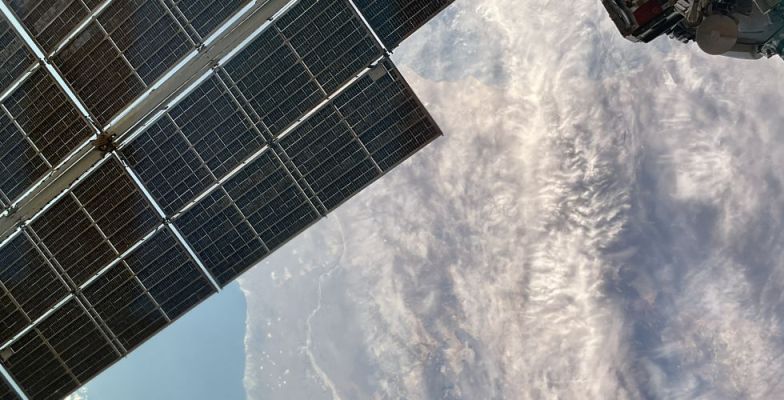
Astronauts aboard the ISS take photographs of the Earth to assess the environmental situation. Roscosmos
Delegates to the 15th Session of the High-Level Policy Consultative Meetings on Satellite Communications agreed to take this relationship to the next level. The meeting, the first in five years, was attended by senior representatives from the space agencies and meteorological community, including the Chairs of the WMO Infrastructure and Services Commissions. The session explored how WMO can support space agencies to meet the data and information needs of their members, while promoting improved access to and use of the vast amounts of data available from the latest and future generations of satellites. The potential of space-based observations to support key WMO strategic priorities, including weather monitoring and forecasting, early warnings for all and the Global Greenhouse Gas Observation Programme, was also considered.

Cosmonauts aboard the ISS monitor forest ecosystems. Roscosmos
The meeting covered a variety of topics, including best practices and growing opportunities in collaboration with the commercial satellite sector to make a global greenhouse gas monitoring system a reality in the coming years. The evolving role of artificial intelligence in weather and climate forecasting was discussed, and the development of the WMO space program and its role in the WMO Global Observing System (WIGOS) Integration Vision to 2040 was reviewed.
The GAMVEKI-GM device measures the total flux density of protons and electrons
The GAMVEKI equipment of the Institute of Applied Geophysics named after Academician E.K. Fedorov (FSBI “IPG”) has successfully passed the flight test stage and was transferred to the mode of operational monitoring of the heliogeophysical situation in low Earth orbit in the interests of the Federal Service for Hydrometeorology and Environmental Monitoring (Roshydromet) .
On February 19, 2024, a meeting was held at Roshydromet on the issue of summing up the results of flight tests and the possible use of small spacecraft measurement data for daily operational monitoring of “space weather”. Management of Roscosmos, MSTU named after. N.E. Bauman, FGBU “IPG”, FGBU “National Research Center “Planet”, Hydrometeorological Center made reports on the results of the completion of the flight testing phase of the small spacecraft “Horse” No. 1 and No. 2.
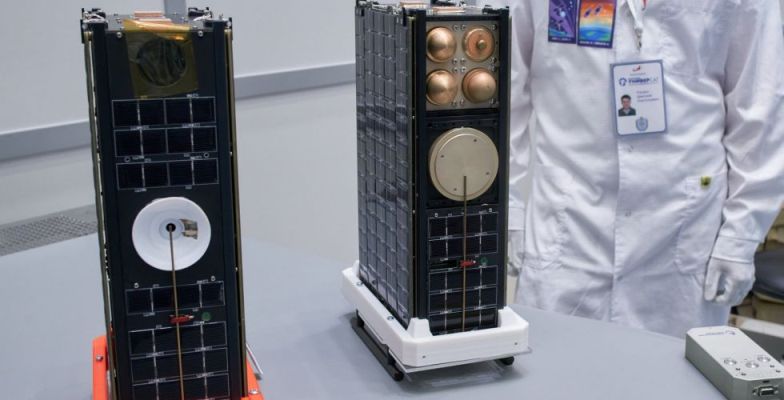
MKA MSTU im. N.E. Bauman entered into an operational monitoring regime in the interests of Roshydromet. Roscosmos
The GAMVEKI equipment consists of two devices: GAMVEKI-GM and GAMVEKI-CH. The GAMVEKI-GM device measures the total flux density of protons and electrons using Geiger-Muller counters in four energy ranges, and the GAMVEKI-CH device measures the flux density of protons with energies greater than 600 MeV in three energy intervals.
Results obtained from MSTU named after. N.E. Bauman, and the established cooperation of the university with the institutes of Roshydromet showed the correctness of the principles and approaches that we laid down in the UniverSat program: testing new technologies, obtaining targeted information, recognizing it by the consumer and supplementing federal satellite constellations with small devices. We expect to develop the successful experience gained while working with Roshydromet by organizing the work of universities with other thematic customers of Roscosmos in promising areas.
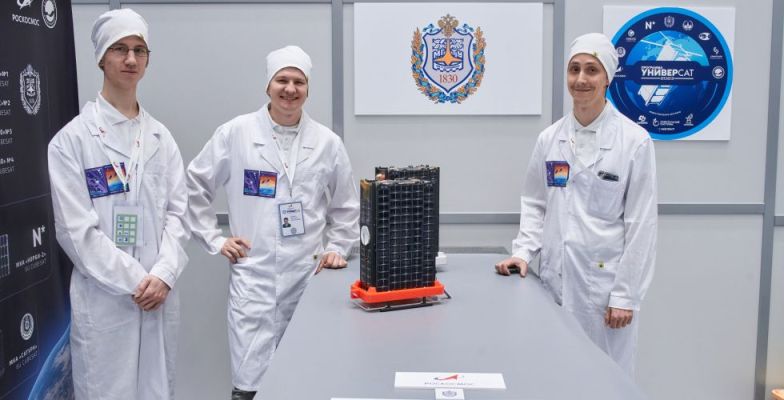
MKA MSTU im. N.E. Bauman entered into an operational monitoring regime in the interests of Roshydromet. Roscosmos
Indian next-generation weather observation satellite INSAT-3DS
The Indian Space Research Organization (ISRO) successfully launched its next-generation weather observation satellite INSAT-3DS into space. As reported by the Indian space agency on X (formerly Twitter), the satellite was launched into orbit on board the GSLV launch vehicle. “Mission GSLV-F14/INSAT-3DS: The launch vehicle successfully launched the satellite into the intended geostationary transfer orbit,” the report said. The rocket took off from the spaceport on the island of Sriharikota in the Bay of Bengal, where the Space Center is located. Satish Dhawan.
The 2,274 kg INSAT-3DS is a third-generation meteorological satellite that will be placed in geostationary orbit. The purpose of the mission is to conduct broad meteorological observations, monitor land and ocean surfaces, and assist in determining weather forecasts and warning of natural disasters. In the coming days, ISRO scientists will conduct a series of maneuvers to place the satellite into a predetermined orbit, the statement said.
Unique microwave scanner/probe MTVZA-GYA
The first global images of the Earth were obtained using the MTVZA-GY equipment and the MSU-MR equipment of the Meteor-M spacecraft No. 2-4. The unique microwave scanner/probe MTVZA-GYA is one of the main types of target equipment on board meteorological satellites of the Meteor-M series, which carries out round-the-clock and all-weather monitoring of the atmosphere and surface of the Earth via 40 spectral channels in the range from 6 to 190 GHz.
MTVZA-GY information is intended to solve a wide range of problems in the interests of operational meteorology, oceanography and numerical weather forecasting. According to MTVZA-GYA data, the vapor content of the atmosphere, water content of clouds, surface wind speed, vertical profiles of temperature and humidity of the atmosphere, etc. are determined.
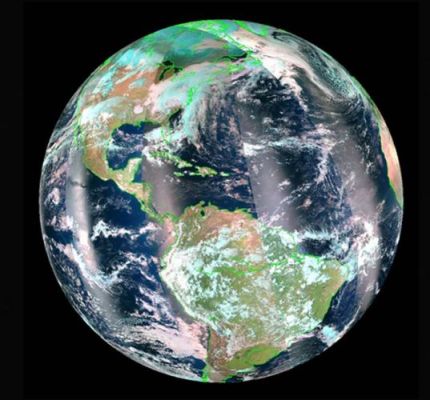
The first global images of the Earth were obtained using the equipment of the Meteor-M satellite No. 2-4. Roscosmos
A multispectral low-resolution scanning device (MSU-MR) provides the formation of a multispectral image in 6 channels from visible to long-wave infrared radiation of the entire Earth’s surface every 24 hours (12 hours in the IR range). The survey is carried out with a spatial resolution of 1000 m and a swath of up to 2900 km. The data is used to generate global static cloud maps, detect fires, and determine the temperature of land, water and ice.
The equipment was developed by the Russian Space Systems holding company. Reception and processing of satellite information is provided by the Scientific Center for Operational Earth Monitoring of JSC Russian Space Systems and the Scientific Research Center for Space Hydrometeorology “Planet”.
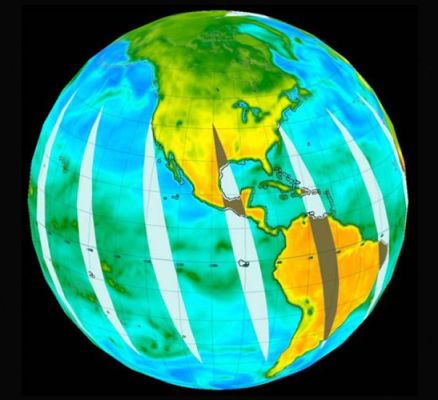
The first global images of the Earth were obtained using the equipment of the Meteor-M satellite No. 2-4. Roscosmos
Study provides new estimates of how much water flows through Earth’s rivers
NASA-led research provides a new global inventory of Earth’s rivers. A new approach to estimating river water reserves and flows also makes it possible to identify regions marked by the “fingerprints” of intensive water use. For the study, which was recently published in the journal Nature Geoscience, researchers from NASA’s Jet Propulsion Laboratory in Southern California used a new methodology that combines stream gauge measurements with computer models of about 3 million river segments around the world.
The study provides new estimates of how much water flows through Earth’s rivers, the speed at which it flows into the ocean, and how much both of these figures have fluctuated over time—important information for understanding the planet’s water cycle and managing freshwater supplies. The results also highlight regions depleted by intensive water use, including the Colorado River Basin in the United States, the Amazon Basin in South America and the Orange River Basin in southern Africa.
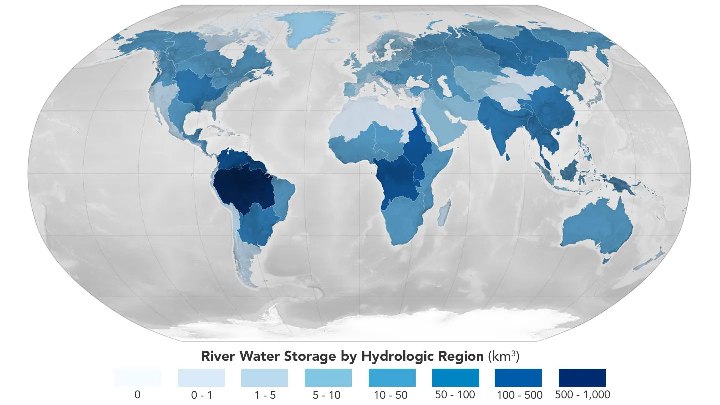
The NASA-led study combined stream gauge measurements with computer models of 3 million river segments to create a global picture of how much water Earth’s rivers hold. The Amazon Basin is estimated to contain about 38% of the world’s river water, more than any hydrological region assessed. NASA
Scientists estimate that the total volume of water in the Earth’s rivers averaged 539 cubic miles (2,246 cubic kilometers) from 1980 to 2009. This is equivalent to half the water of Lake Michigan and approximately 0.006% of all fresh water, which itself is 2.5% of the world’s volume. Despite their small share of all water on the planet, rivers have been vital to humans since the earliest civilizations.
While researchers over the years have made numerous estimates of how much water flows from rivers to the ocean, estimates of the total volume of water in rivers (known as storage) have been few and more uncertain, said JPL co-author Cedric David of the study.
The study determined that the Amazon basin is the region with the largest volume of river reserves, holding about 204 cubic miles (850 cubic kilometers) of water, approximately 38% of the global estimate. The same basin releases the most water into the ocean: 1,629 cubic miles (6,789 cubic kilometers) per year. That’s 18% of global ocean discharges, which averaged 8,975 cubic miles (37,411 cubic kilometers) per year between 1980 and 2009.
While a negative river flow is not possible—the study’s approach does not account for upstream movement—for accounting purposes, some sections of the river may have less water flowing out than flowing in. Here’s what the researchers say. It is found in parts of the Colorado, Amazon and Orange river basins, and in the Murray-Darling basin of south-eastern Australia. These negative flows generally indicate intensive human use of water.
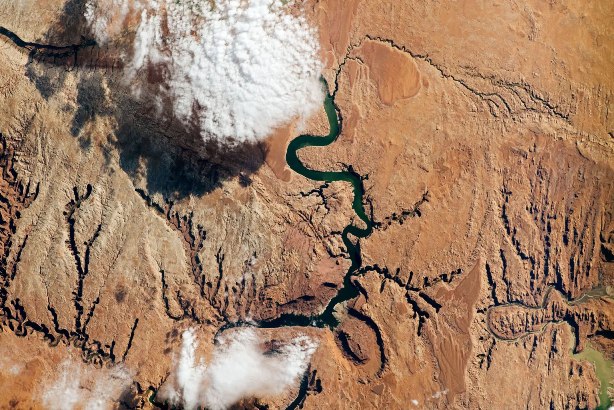
The Colorado River supplies water to more than 40 million people as it flows through seven U.S. states, including a portion of southeastern Utah seen in this photo taken by an astronaut aboard the International Space Station. The Colorado Basin was identified in a NASA-led study as a region where humans use water intensively. NASA
For decades, most estimates of the total amount of river water on Earth were revisions of 1974 United Nations data, and no study showed how that amount changed over time. Another problem was that large rivers have many more gauges to control water levels and flows than small ones. There is also great uncertainty in estimates of runoff—the rainwater and melted snow that flows into rivers.
The new study began with the premise that the flow flowing into and through a river system should roughly equal the volume measured by sensors downstream. Where the researchers found discrepancies between modeled runoff from three land surface models and sensor measurements taken at about 1,000 locations, they used sensor measurements to adjust the modeled runoff rates.
They then modeled flow through the rivers on a high-resolution global map developed using land elevation data and imagery from space, including NASA’s Radar Topography Mission. This approach produced flow data that was used to estimate average and monthly water volumes for individual rivers and the world’s rivers as a whole. Using a consistent methodology allows flows and population declines to be compared between different regions.
International Space Station in the field of collecting climate-related data
The International Space Station has many instruments collecting different types of climate-related data. Because the station’s orbit passes more than 90 percent of the Earth’s population and circles the planet 16 times a day, these instruments allow viewing of multiple locations at different times of the day and night. This data informs climate decision-making and helps scientists understand and solve the problems caused by climate change. Although crew members have little involvement in the day-to-day operation of these instruments, they play a critical role in unpacking the equipment when it arrives at the space station, as well as in assembling and installing the instruments during spacewalks or using the station’s robotic arm.
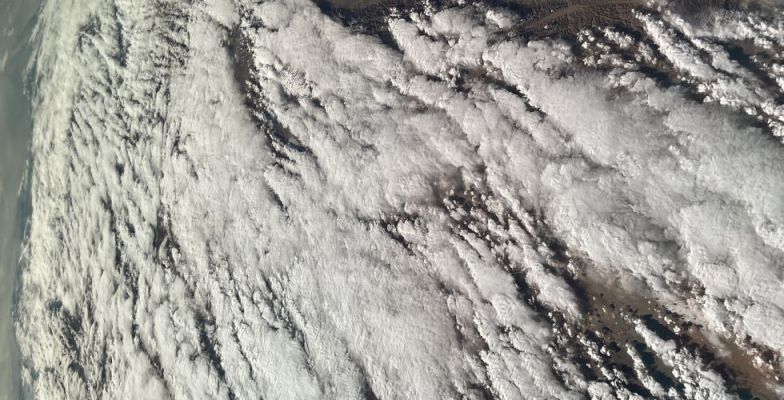
Cosmonauts aboard the ISS monitor forest ecosystems. Roscosmos
One of the orbiting laboratory’s studies that contributes to efforts to monitor and address climate change is the ECOsystem Space Thermal Radiometer Experiment on the Space Station (ECOSTRESS). It provides thermal infrared measurements of the Earth’s surface that help answer questions about water stress in plants and how specific regions respond to climate change. Research confirmed the accuracy of ECOSTRESS 1’s surface estimates and found that photosynthesis in plants begins to stop at a temperature of 46.7 degrees C (114 degrees F). In some tropical regions, average temperatures are rising by 0.5 degrees Celsius per decade, and temperature extremes are becoming more pronounced. Tropical forests are a major producer of oxygen, and without sufficient climate change mitigation, leaf temperatures in these tropical forests could soon approach this destruction threshold.
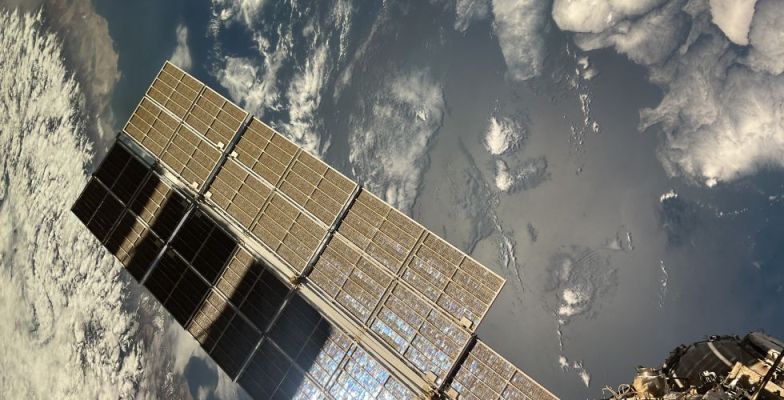
Astronauts aboard the ISS help identify natural disasters on Earth. Roscosmos
The Total and Spectral Solar Irradiance Sensor (TSIS) measures total solar irradiance (TSI) and spectral solar irradiance (SSI). TSI is the total amount of solar energy reaching Earth, while SSI measures the sun’s energy in individual wavelengths. Energy from the Sun drives atmospheric and oceanic circulation on Earth, and knowledge of its magnitude and variability is essential to understanding Earth’s climate. The researchers tested the instrument’s performance and showed that it produced more accurate measurements than previous instruments. TSIS maintains a continuity of nearly 40 years of solar irradiance data derived from space-based observations.

Astronauts aboard the ISS help identify natural disasters on Earth. Roscosmos
The Global Ecosystem Dynamics Study (GEDI) monitors global forests and topography using light detection and ranging (lidar). These observations can provide insights into important carbon and water cycling processes, biodiversity and habitats. One study used GEDI data to estimate pantropical and temperate biomass densities at the national level for each country observed and at the subnational level for the United States.

A group of methane plumes discovered by EMIT in 2022 over an area of approximately 150 square miles in Uzbekistan. EMIT captured in an instant what would have been a 65-hour flight with an on-board instrument. NASA
The Earth Surface Mineral Dust Survey (EMIT) determines the type and distribution of minerals in dust from arid regions of the Earth using an imaging spectrometer. Mineral dust influences local warming and cooling, air quality, snow melt rates, and ocean plankton growth. The researchers demonstrated that EMIT data can also be used to identify and monitor specific sources of methane and carbon dioxide emissions.
Carbon dioxide and methane are the main anthropogenic drivers of climate change. Increasing emissions in regions with poor reporting requirements creates significant uncertainty in the global carbon budget. The high spatial resolution of EMIT data can allow precise monitoring of even sources located close to each other.
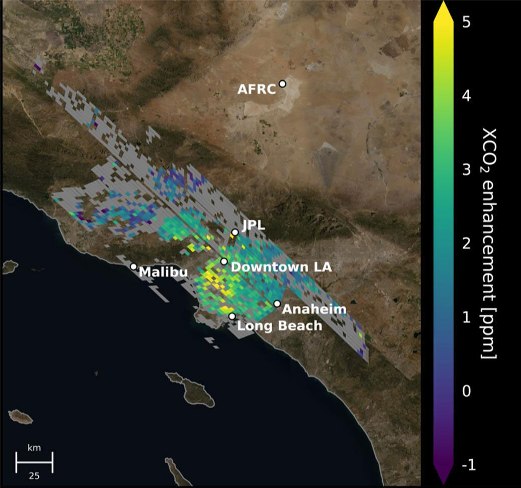
This image compiles OCO-3 data showing carbon dioxide concentrations in Los Angeles. NASA
The station’s Orbiting Carbon Observatory-3 (OCO-3) collects data on global carbon dioxide levels during solar hours, mapping emissions at targeted local hot spots. This type of satellite remote sensing helps evaluate and verify emissions reductions included in national and global plans and agreements. Monitoring of 30 coal-fired power plants between 2021 and 2022 by OCO-3 and the Italian Space Agency’s PRecursore IperSpettrale della Missione Applicativa (PRISMA) satellite showed the same data. This result suggests that, under the right conditions, satellites can provide reliable estimates of emissions from discrete sources. Combustion for electricity and other industrial purposes accounts for approximately 59% of global anthropogenic carbon dioxide emissions.

This image shows about three years of SAGE III aerosol data from around the world, showing the impact of wildfires and volcanic eruptions on the atmosphere. NASA
The Stratospheric Aerosols and Gases Experiment III-ISS (SAGE III-ISS) measures ozone and other gases and tiny particles in the atmosphere called aerosols, which together act as Earth’s sunscreen. The device can distinguish between clouds and aerosols in the atmosphere. The study found that aerosols dominate the Earth’s tropical upper troposphere and lower stratosphere, the transition region between the two atmospheric levels. Continuous monitoring and identification of these atmospheric layers helps quantify their impact on the Earth’s climate.
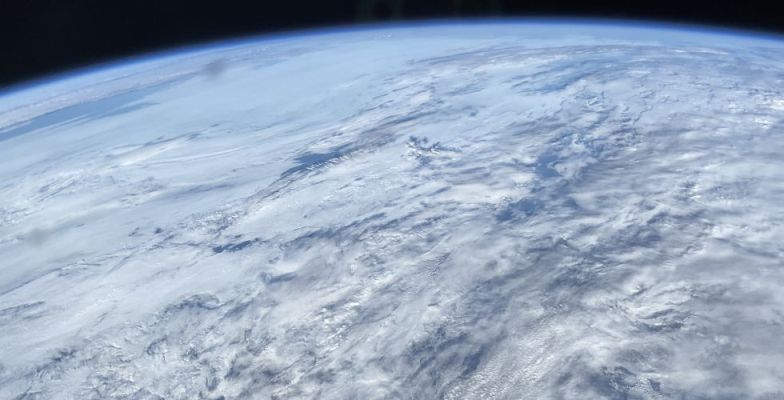
Astronauts aboard the ISS help identify natural disasters on Earth. Roscosmos
An early remote sensing system, the ISS SERVIR Environmental Research and Imaging System (ISERV), captured images of the Earth at preprogrammed intervals through a window on the space station with high-quality optics known as the Window Observational Research Facility (WORF). The researchers reported that this type of Earth observation is critical for applications such as mapping land use and estimating carbon biomass and ocean health.
TerraPulse helps businesses make informed decisions about their environmental impact
For more than 50 years, NASA’s Landsat satellites have been recording changes in the surface of our planet. Now North Potomac, Maryland-based terraPulse Inc. is using artificial intelligence to create meaningful maps that help academic institutions, non-governmental organizations and businesses understand the many impacts of climate change.
By combining data from multiple NASA and European satellites, terraPulse helps businesses make informed decisions about their environmental impact. The same data helps scientists understand environmental changes and the processes that cause them, which can provide actionable information to local decision makers for infrastructure planning and disaster preparedness.
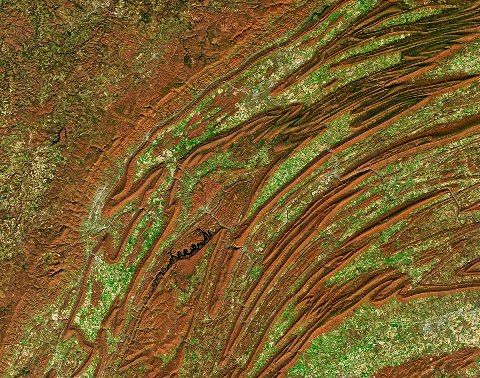
This natural-color Landsat 8 image of the central Pennsylvania mountains shows the colors of changing leaves and the region’s unique topography. With more than 50 years of observing planets from low Earth orbit, both natural and man-made changes can be seen. NASA
Measurements taken from space are still undergoing significant research and development. NASA’s Geosciences Division is funding several remote sensing initiatives to advance our understanding of the impacts of land cover change, including the terraPulse project using FitBits to track and assess the health of wild deer and the impacts of changing their habitat.
NASA’s Goddard Space Flight Center in Greenbelt, Maryland, which manages many of the agency’s Earth monitoring satellite missions, maintains a comprehensive view of our planet. Industries are turning to satellite data to plan climate change resilience by monitoring facilities around the world, identifying manageable risks and more.
NASA’s PACE (Plankton, Aerosol, Cloud, Ocean Ecosystem) satellite data benefits ecosystems and human health
In the years leading up to the February 2024 launch, NASA mission managers teamed up with dozens of applied scientists and environmental scientists to prepare for the many practical applications that PACE data could reveal. The PACE Early Adopter Program integrates scientific evidence into business, environmental management, and decision-making for the benefit of society.
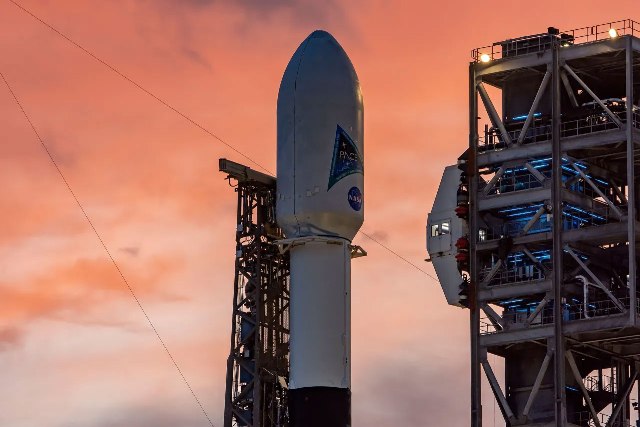
A SpaceX Falcon 9 rocket carrying NASA’s PACE (Plankton Aerosol Cloud Ocean Ecosystem) spacecraft stands upright on Space Launch Complex 40 at Cape Canaveral Space Force Station in Florida on February 5, 2024. PACE is NASA’s newest Earth-observing satellite that will help improve our understanding of Earth’s oceans, atmosphere and climate by providing hyperspectral observations of microscopic marine organisms called phytoplankton, as well as new data on clouds and aerosols. SpaceX
Researchers specialize in a wide range of topics, including water resources, fisheries and aquaculture, air quality and health, climate and agriculture. These early adopters of science serve as a bridge between the PACE team and local communities and decision makers who need affordable products for public use. Such work can help connect new horizons of PACE hyperspectral and multi-angle polarimetric data to real-world problems—and find new ways to solve problems.
In coastal communities, knowledge of water quality is essential to healthy ecosystems, safe and sustainable seafood and recreation, not to mention the livelihoods of people who depend on fisheries.
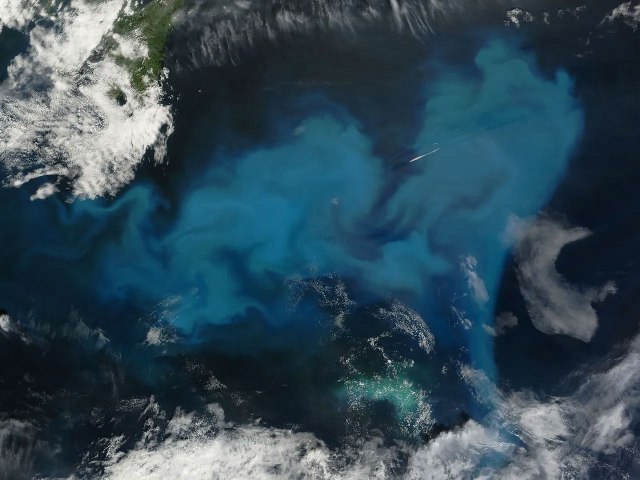
Phytoplankton are microscopic organisms that live in aquatic environments. When conditions are right, phytoplankton populations undergo explosive growth, creating blooms visible from space. This bloom occurred in the North Atlantic Ocean, off the coast of Newfoundland, in early August 2010. The Moderate Resolution Imaging Spectroradiometer (MODIS) on NASA’s Terra satellite captured this natural-color image on August 9, 2010, with the blue color being phytoplankton. NASA/Goddard/Jeff Schmaltz/MODIS Land Rapid Response Team.
Marina Marrari, executive director of the Costa Rican Fisheries Federation in San Jose, and her colleagues have developed a mobile app that will pull data from PACE’s Ocean Color Instrument to educate the public about harmful algal blooms. The app, known as pezCA, disseminates near real-time data on ocean temperatures, chlorophyll concentrations and currents measured by other NASA satellites. Once PACE data is available, the app will be updated to include information about specific types of harmful algal blooms that can have toxic effects on people and animals.
Information on air quality and air particles (aerosols) is generally available for densely populated urban areas such as Los Angeles, Atlanta and New York. Marcela Loria-Salazar, an assistant professor at the University of Oklahoma in Norman, plans to use data from the PACE and OCI polarimeters to study air quality in places in the central United States that tend to have fewer ground-based monitors.
Urban pollution emissions, desert dust and wildfire smoke can travel from distant places – across continents or even oceans. (Think of the smoke from wildfires that could spread from Alaska and Canada into the central US.) PACE collects global data on this dust and smoke in the Earth’s atmosphere every one to two days, and this data is publicly available – that is, it available to anyone. find and download for free on the Internet.

Smoke from wildfires in Canada is slowly spreading south over the midwestern United States. Drifting smoke can be seen in this Terra satellite image taken in December 2017 over Lake Michigan, as well as parts of Minnesota, Wisconsin, Indiana and Ohio. NASA MODIS Rapid Response Team/Jeff Schmaltz
Phytoplankton are the center of the marine food web. These microscopic organisms provide food for larger animals such as zooplankton, fish and shellfish, and eventually whales and dolphins. While PACE cannot directly detect fish or mammals below the ocean’s surface, it can view phytoplankton communities, which can inform scientists about the ocean ecosystem in which fish and mammals live.
By studying phytoplankton, scientists can gain valuable information about changes occurring in marine habitats, as these microorganisms often serve as early indicators of the health of a regional ecosystem. Liz Ferguson, CEO and marine ecologist at Ocean Science Analytics, studies marine mammals off the Pacific coast of North America. Monitoring planktonic communities enhances scientists’ ability to understand the complex dynamics of marine ecosystems. By carefully monitoring changes in environmental variables and the behavior of indicator species such as marine mammals, Ferguson can study the effects of climate change on California Current ecosystems.
Some species of phytoplankton produce toxins that can be harmful to people, pets and livestock. When these phytoplankton reproduce in large numbers, it is called a harmful algal bloom.
Richard Stumpf and Michelle Tomlinson, oceanographers at the National Oceanic and Atmospheric Administration (NOAA), are using satellite data to study the bloom and help educate communities about its risks. They used data from the ocean and land color instrument on the European Space Agency’s Sentinel-3 satellite, which collects data about Earth by measuring specific wavelengths of light. PACE’s Ocean Color Instrument sensor does the same thing, but as a hyperspectral instrument it can detect more than 200 wavelengths—more than five times the amount observed by Sentinel-3 and other current instruments.
PACE’s hyperspectral capabilities could allow scientists and conservationists to not only detect incipient blooms, but also identify the specific phytoplankton communities that make up those blooms. Finding these details helps scientists better inform local water managers about the location, timing and type of harmful algal blooms, which can help reduce risks to the public.
SpaceX rocket launches groundbreaking methane tracking satellite – MethanSAT
A new satellite that will track climate-warming methane emissions from oil and gas companies around the world has launched from California’s Vandenberg Space Force Base. The washing machine-sized satellite, called MethanSAT, launched on March 4 on a Falcon 9 rocket, one of 53 payloads on SpaceX’s Transporter-10 mission.
MethanSAT is intended to ultimately help policymakers independently vet industry reports by identifying hotspots of methane, an invisible but powerful greenhouse gas that traps far more heat in Earth’s atmosphere per molecule than carbon dioxide. According to the mission plan, MethanSAT, the nonprofit environmental group’s first satellite, will collect data on methane leaks from 300 sites around the world as it circles the Earth 15 times a day from its orbit 360 miles (580 kilometers) above the earth.
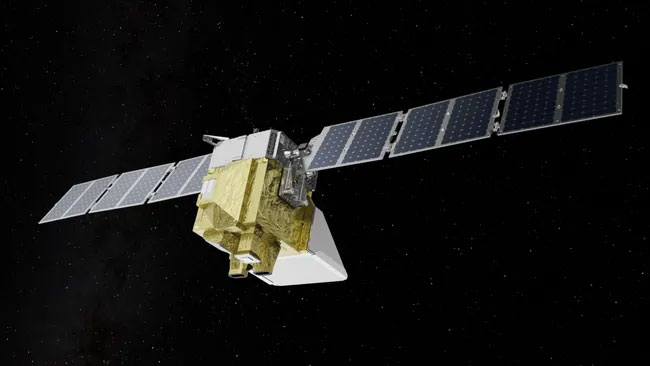
Artist’s concept of MethanSAT in orbit. (Image: MethanSAT/EDF)
Methane is the main component of natural gas that is burned during industrial activities in power plants and factories around the world. An analysis by EDF found that US natural gas pipelines leak between 1.2 and 2.6 million tons of methane per year. When methane enters the atmosphere from such leaks, it acts like a blanket, absorbing heat and reducing the rate at which it escapes into space.
The satellite was developed by EDF in partnership with the New Zealand Space Agency, Harvard University, British aerospace company BAE Systems and Google for $88 million. Google will provide cloud computing services to the MethanSAT team to process satellite data, and will also help improve EDF’s oil and gas infrastructure database “so that region-specific emissions data can be accurately attributed to audited assets.”
The first images from the satellite are expected in early summer and will be available to the public later this year, EDF officials said. This information can help companies, policymakers and governments take a more critical look at the progress made in combating climate change. In addition to collecting data from these sources, MethanSAT will primarily focus on oil and gas companies due to their dominant share of global emissions as well as their perceived potential to reduce emissions.
Russian Prime Minister Mishustin: strengthening the constellation of Arctic weather satellites will improve monitoring of the Northern Sea Route
Strengthening the constellation of Arctic weather satellites will give Russia the opportunity to provide the highest quality round-the-clock monitoring of the Northern Sea Route, said Russian Prime Minister Mikhail Mishustin. Mishustin took part in the Roshydromet board, before which he inspected the exhibition on geophysical and space monitoring. Among other things, he was presented with the unique hydrometeorological satellites “Arktika-M”.

The head of Roshydromet, Igor Shumakov, who led the tour, called these satellites a pride. “When we launched the device, the first congratulations came from our American colleagues with the inscription “The Russians have started star trek,” he noted. Hydrometeorological satellites “Arktika-M” are created on the basis of the unified platform “Navigator” produced by the Scientific and Production Association named after S. A. Lavochkin. The devices are designed for round-the-clock all-weather monitoring of the surface of the Earth and the seas of the Arctic Ocean, and they will also provide constant and reliable communication. In addition, the satellites are capable of relaying signals from radio beacons of the international search and rescue system COSPAS-SARSAT.
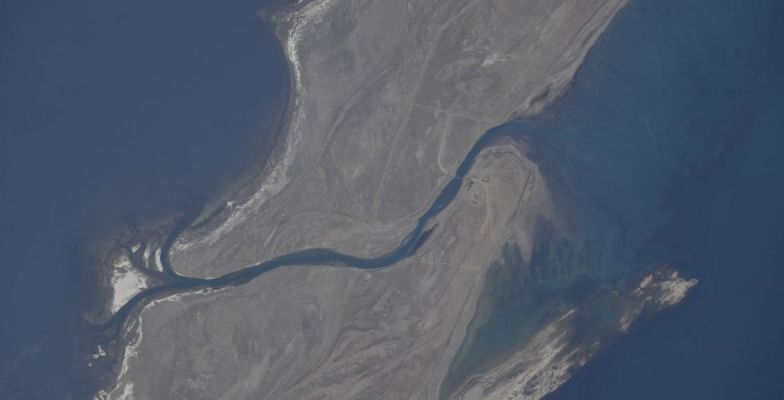
Astronauts aboard the ISS help predict natural and man-made disasters on Earth. Roscosmos




